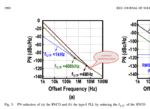diego.fan
Member level 3
Hi, I'm reading papers of VCO which mention 1/(f^3) corner should be reduced to optimize phase noise. But in my opinion,the slope of phase noise lower than 1/(f^3) corner is -30dBc/dec, and the slope of phase noise higher than it is -20dBc/dec. In this case, 1/(f^3) corner should be as high as possible to let phase noise decrease quickly. May I ask where I'm wrong? Thanks.

